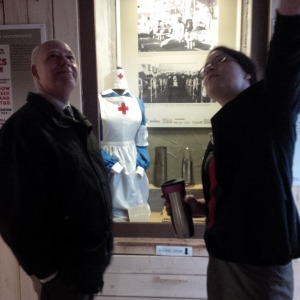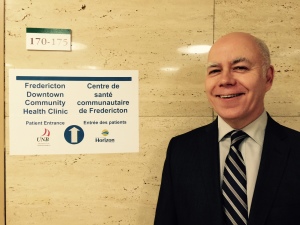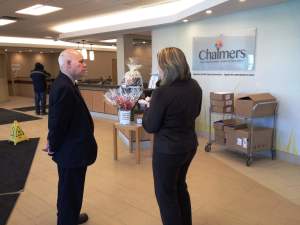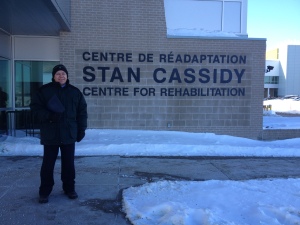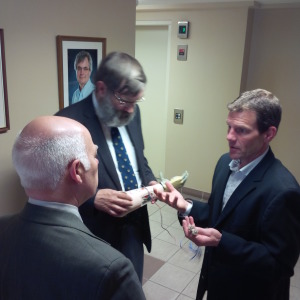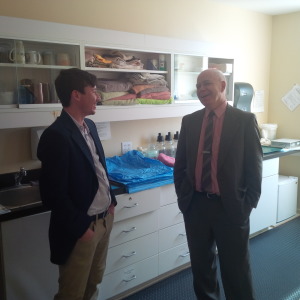In Your Community: Health Facilities
Since his election last September, David has been connecting with community centres and organizations in his constituency. He has been impressed time and time again with the skills, knowledge, goodwill, generosity and creativity manifested in the many institutions, businesses, schools and centres in Fredericton South. This section highlights some of the facilities and groups David has gotten to know since assuming office.
In the last few months, his focus has been on healthcare institutions, including the Downtown Community Health Centre, the Dr. Everett Chalmers Hospital (DECH), the Stan Cassidy Rehab Centre, the UNB Institute of Biomedical Engineering, and Clinic 554.
David has discovered the wealth of medical knowledge, skills and innovation happening in Fredericton South. Some of these impressive institutions are little known beyond the medical community and those benefiting from their services. They offer a wide range of innovative care and resources, often leading the way in their respective field.
The new Downtown Community Health Centre is a great example. David was invited to visit the centre by nurse manager, Joan Kingston. The centre draws together a team of professionals who deliver a wide range of services using a collaborative model of health care delivery.
In addition to offering client services, the centre is a teaching facility, training nurse interns and community volunteers in the basics of patient-centered care. It is also becoming recognized as a leading research facility in the area of community-based health care.
Community health centres such as this are key to reducing the strain on hospitals, making healthcare more accessible, reducing the number of people without family doctors, making care more personal and compassionate, and improving the overall quality of care. As David stated in his response to the speech from the throne, “We need to be building publicly run community health centres to move health care out of our hospitals and into our communities.” With hospitals becoming increasingly crowded, community health centres are more important than ever.
David next went up the hill to the Dr. Everett Chalmers Hospital where Executive Director Nicole Tupper took him on a tour. The effects of over-crowding were quickly evident. In some units, patients or their loved ones sat in hallways functioning as waiting rooms. In others, hallways were lined with carts of medical supplies and equipment because there was no storage space available. In the pediatric unit, the teens had only the children’s playroom to use because their lounge had been converted into adult bed space.
The labour and delivery wing accommodates the highest number of births in New Brunswick, but is unable to provide the latest standard of care because they do not have the space. The intensive care unit had staff working so closely together there was hardly room to move.
“It’s a lot of juggling,” said Tupper. “We make do with what we have and do what we can, but it’s a challenge for sure.” Tupper regularly greeted staff by name throughout the tour. “We have a phenomenal staff,” she said. “We hear a lot of positive stories even though they work in less than ideal conditions.”
“This hospital is bursting at the seams,” David said, “Improvements are needed across the entire hospital, from labour and delivery to intensive care. It is essential that the next capital budget enables the Chalmers hospital to get back on track with their renovation plans,” he added. This tour resulted in an article in the Daily Gleaner drawing attention to the plight of the over-crowded conditions and the need for renovation.
Right next door to the hospital is a shining example of one of the province’s medical gems.
The Stan Cassidy Centre for Rehabilitation is leading Atlantic Canada in rehabilitative therapy for those with neurological conditions or traumatic neurological injuries. It has a team dedicated to pediatric autism and a series of engineers and occupational therapists developing cutting edge assistive or adaptive technologies for individuals. It is a mandatory destination for Atlantic medical students specializing in physiatry (rehabilitation medicine). It is also the premier destination for both children and adults phasing out of acute care into more long-term therapy after major injuries or strokes.
The patient-centric approach taken by the centre is uniquely team-based. Each patient is assigned a network of health professionals to help guide them. These teams are composed of various health professionals who work with the eighteen or so inpatients and countless outpatients through outreach clinics in their communities.
“Everybody knows someone who has spent time here and has benefited from the experience,” said Alissa Lee, Executive Director of the Stan Cassidy Foundation and host of David’s tour. Lee continued to describe the immense generosity she has witnessed throughout some of the projects the Foundation has implemented.
David was not surprised to hear this. “The people of Fredericton are a socially conscious, generous group,” he said. “They are also incredibly talented. The innovative work happening at this Centre is just another example of the excellence that exists in this riding and within this province.” Another example of such excellence, also little known, is the UNB Institute of Biomedical Engineering.
On a spring day, David visited the UNB Institute of Biomedical Engineering and the Atlantic Centre for Upper Limb Prosthetics. Dr. Kevin Englehart, Director of the Institute, and Dr. Ed Biden, Professor in UNB’s Mechanical Engineering faculty, showed him around. The Institute of Biomedical Engineering fits about 90% of the powered upper limbs in Atlantic Canada. The Centre is celebrating its 50th anniversary this year. By mixing the academic research of the Institute with the clinical applications in the Centre, specialists at UNB are providing cutting edge service to patients and observing the impact of their research immediately. This model is unique in the industry.
In addition to prosthetics, staff at the Centre fashion adaptive technologies to help patients regain the quality of life they had before losing a limb. Some examples include a prosthetic with shock absorbers for a child who loved mountain biking and a specialized kayak paddle for a young person with only one arm.
Since the Currie Centre opened at UNB, much of the research element has moved to the Motion Analysis Lab attached to the indoor track. This facility allows clients to move through the lab while researchers record and study a patient’s mobility. Only six facilities in the world have this setup.
The shared emphasis on research excellence and patient experience at the Institute and the Centre is what makes it so special. The researchers and clinicians are leading the field, providing expert service for the people of Atlantic Canada. Just another example of the many hidden gems within our own community of Fredericton South.
Last, but not least, David made a visit to a clinic that has received much attention this past year. With the closure of the Morgentaler Clinic in 2014, a groundswell of support saw not only the reopening of the clinic as Clinic 554, but also the election of a government whose platform promised to make abortion more accessible.
Dr. Adrian Edgar and his clinic manager Valerie Edelman, hosted David on a tour of this special clinic, one that caters specifically to the needs of underserved populations including lesbian, gay, bisexual, two-spirited, trans-gender, and queer individuals; and offers a wide variety of reproductive health services including contraceptive counselling, pregnancy management, and abortions. This family practice opened on January 16, 2015 and is in the process of accepting 600 patients from the provincial patient registry.
Dr. Edgar has a vision to grow Clinic 554 into a complete care centre for women. Part of that vision involves bringing a midwife onto the team.
Having received patients since January, Dr. Edgar and his staff are concerned at the barriers to abortion services that still exist in the province. In November, the Premier decided to remove the restriction requiring two doctors to certify an abortion as medically necessary. However, the province refuses to make abortions a billable service through Medicare. Patients who are unable to travel to the new family planning clinic in Moncton, or who require the privacy and timeliness of the Fredericton-based clinic are forced to pay between $700 and $800. Dr. Edgar is an advocate for changes to Medicare which will allow for truly publicly-funded abortions. He argues that the current structure creates a two-tiered system that disadvantages local women, especially those in a position of economic vulnerability.
Dr. Edgar wants to create a safe space to provide patient-centred and patient-driven care to the people of Fredericton and the surrounding region.
For more information on all the centres and clinics above, please visit the websites for each:
Downtown Community Health Centre
If you would like David to visit your organization, please contact Taeyon at his Constituency Office.
e-mail: taeyon.kim@gnb.ca
phone: 506-455-0936
